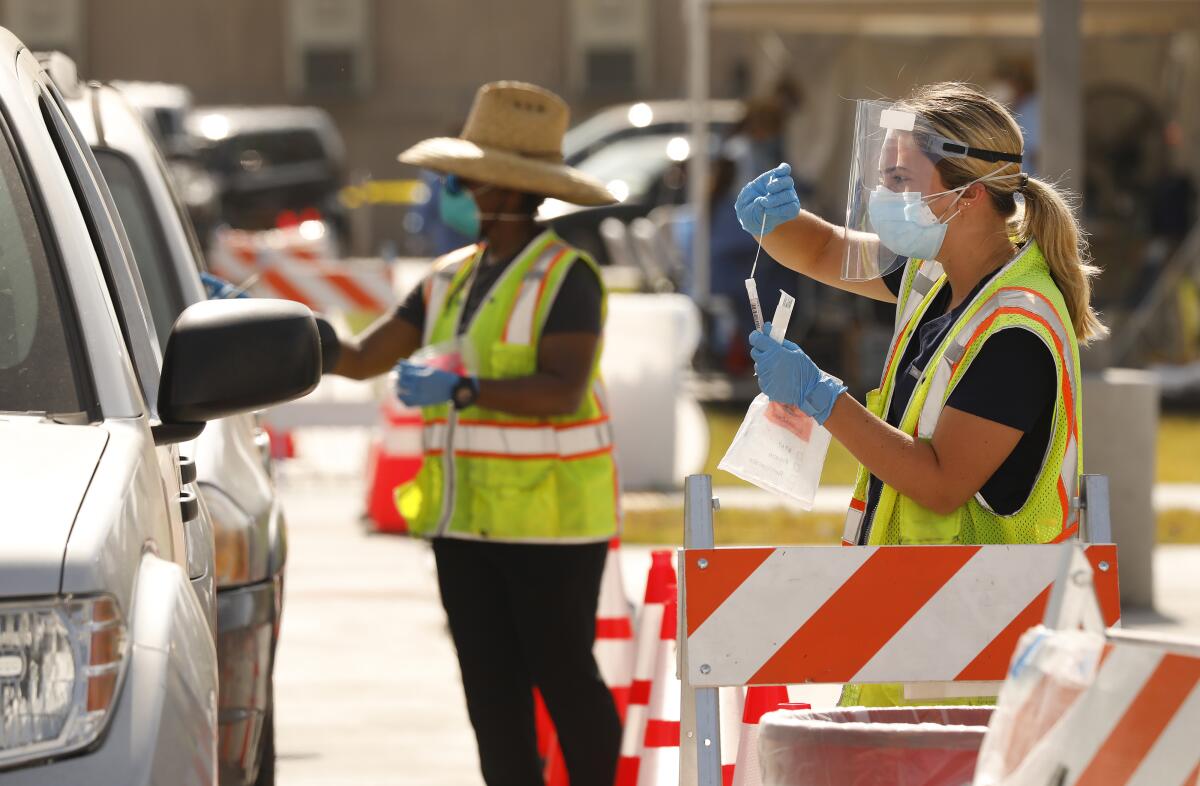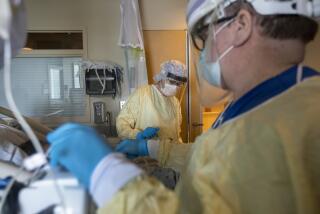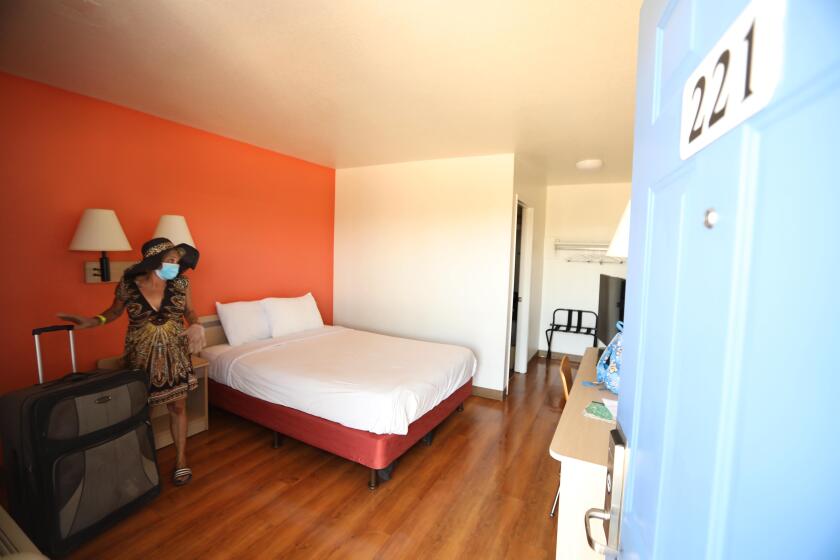California officials rolling back reopenings as coronavirus surge creates new crisis

With the coronavirus death toll in California jumping past 7,000 and cases continuing to surge, more parts of the state are rolling back reopening plans as they try desperately to slow outbreaks and prevent more hospitals from hitting capacity.
California has seen coronavirus cases and hospitalizations skyrocket in the last month as the economy has reopened and residents have gone back to summer socializing. Although the state clamped down by shutting bars and banning indoor dining in many areas, officials described the conditions as critical.
The rate at which COVID-19 tests are coming back positive in California over the previous seven days hit 8.3% on Sunday. That’s the highest percentage since April — a continuing sign that the coronavirus is spreading throughout the state, according to a Los Angeles Times analysis conducted over the weekend.
A week ago, on July 5, the so-called positivity rate over the previous seven days was 6.8%; and the Sunday before that, on June 28, it was 5.9%. The positivity rate in Los Angeles County is even worse than the statewide figure. On Friday, the seven-day positivity rate was 10% in L.A. County; in late May, that rate fell to a low of 4.6%.
Alarmed at the metrics, some Bay Area counties are scaling back.
Officials in Alameda County said they had been informed by the state that outdoor restaurant dining there was no longer allowed and restaurants could only be open for drive-through, pickup or delivery service. Indoor restaurant dining has never reopened in Alameda and several other Bay Area counties.
In Contra Costa County, officials issued an order Saturday prohibiting indoor religious services beginning Monday morning. Outdoor gatherings, including worship services and political protests, will still be allowed as long as rules on face coverings and physical distancing are followed.
Contra Costa County officials said in a statement that more than 8% of its COVID-19 tests were now coming back positive over the previous seven days, “a sign that the virus is spreading rapidly in the county and that the community must take immediate steps to reduce the spread of the coronavirus and prevent our healthcare system from becoming overwhelmed.”
“Contra Costa is especially concerned about the risk of COVID-19 transmission in indoor gatherings, and in gatherings that involve removing face coverings for eating and drinking,” officials said in a statement. Health authorities say they are now “concerned that the number of patients needing intensive care could quickly exceed capacity.”
In Santa Clara County, officials were rescinding part of the region’s relaxation orders that were scheduled to take effect Monday. The county had initially planned to allow indoor gatherings of up to 20 people. But officials now say they will not move forward.
“Our county is at a critical moment,” Dr. Sara Cody, the county’s health officer, said in a message posted Saturday on social media. “Right now, the numbers we are seeing aren’t going in the right direction. … The number of people hospitalized with COVID-19 is growing every day.”
The county is, however, allowing hair and nail salons, massage parlors and gyms to reopen starting Monday, with some strict new requirements not seen in other counties, such as prohibiting the indoor use of cardio machines, such as treadmills, elliptical machines, exercise bikes and other equipment that induces heavy breathing or an elevated heart rate. Officials said there were no plans to reopen bars or indoor dining rooms at restaurants for the foreseeable future.
Over the weekend, state health officials ordered Sonoma and Placer counties to prohibit many indoor businesses, including indoor dining, indoor winery tasting rooms and movie theaters.
Los Angeles County tallied more than 3,200 new cases of the virus Sunday and 14 related deaths, according to the Los Angeles Times’ coronavirus tracker.
With that, the county has now recorded more than 133,000 confirmed cases and more than 3,800 deaths. That means L.A. County residents account for 54% of the state’s coronavirus-related deaths, despite making up about one-quarter of the state’s population.
Hospitalizations also continue to climb, both statewide and in L.A. County.
As of Saturday, there were 6,322 people with confirmed coronavirus infections in hospitals statewide, a decrease of less than 1% from Friday’s total of 6,357. Saturday’s figure was the second-highest number of hospitalized patients with confirmed viral infections so far in this pandemic.
There were 1,806 people with confirmed viral infections in California’s intensive care units Saturday — tying the record set Friday for the highest such number.
Los Angeles County also recorded a new high in hospitalizations on Friday, with 2,093 people reported hospitalized with confirmed coronavirus infections; that number dropped less than 2% on Saturday, when 2,056 people were confirmed to be in the hospital.
In June, there were an average of about 1,500 patients with confirmed coronavirus infections in L.A. County hospitals.
“We have been battling this virus for several months and I know that ‘COVID fatigue’ is a very real thing,” Barbara Ferrer, the county health director, said in a statement. “I want to encourage everyone to remain vigilant and continue to use all the tools we have to prevent further transmission of the virus.”
Officials said the increase in transmission probably started around the week of Memorial Day and attributed it to more people being in contact with one another due to more workplaces reopening and more social gatherings taking place.
In an attempt to limit the increase, the county partially rolled back its economic reopening on orders from the state. Bars in a number of counties, including Los Angeles, were made to shut down again June 28, and restaurants were also told to stop in-person dining in many counties on July 1.
Of California’s 58 counties, 31 have now been required to close bars and indoor operations of certain businesses, which not only include dine-in restaurants, but also movie theaters, bowling alleys, arcades and museums.
The orders affected more than 33 million Californians, or more than 85% of the state’s population.
Meanwhile, L.A. Mayor Eric Garcetti warned that the city could reimpose a mandatory stay-at-home order if conditions continued to worsen.
Lin reported from San Francisco, Wigglesworth from Southern California.
More to Read
Start your day right
Sign up for Essential California for news, features and recommendations from the L.A. Times and beyond in your inbox six days a week.
You may occasionally receive promotional content from the Los Angeles Times.









